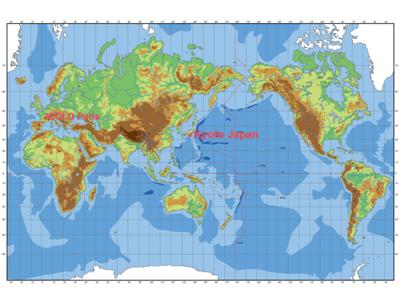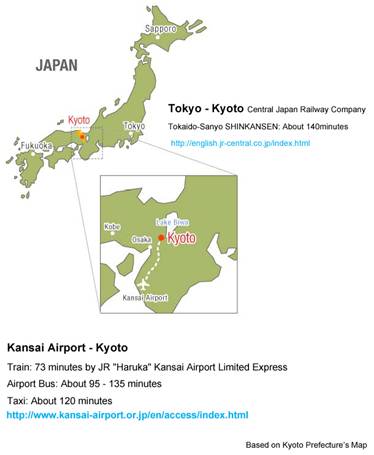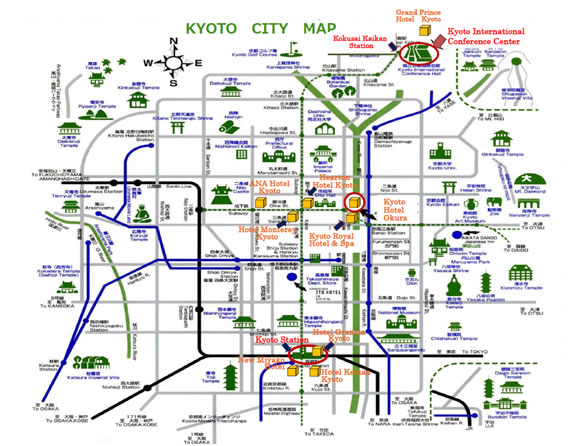Kyoto Prefecture stretches out from the southeast to the northwest in the central and northern parts of the Kansai region. It has four geographical features, the saw-toothed coastal area around Maizuru Bay in the northeast, the Tanba Mountains around its center, the Kyoto Basin in the southeast, and the Yamashiro Basin.
Kyoto became the capital of Japan in the 8th century. It flourished as the center for Japanese politics, economy and culture for some 1,100 years, until the capital functions were transferred to Tokyo in the mid-19th century. There remain many temples and shrines in Kyoto that were built during this long period. Seventeen historic sites including, Kiyomizu-dera Temple and Nijo Castle, are inscribed as World Cultural Heritage Sites.
So many aspects of characteristic Japanese culture continue to thrive in Kyoto. For this reason, Kyoto is often called "Japan's heartland", and it is said that it is impossible to know the real Japan without knowing Kyoto.
On the other hand, Kyoto is not simply protecting its old traditions and culture, but is rather building upon the rich traditions of predecessors as a foundation for open domestic and international exchange. It is a city which maintains a revolutionary spirit, a city of ideas and the cultural capital of Japan, constantly creating new traditions. In a partnership of trust with the people, efforts are made to create a "relaxing lifestyle in a vibrant city", as a positive response towards the new era, while simultaneously protecting and developing traditional culture. Kyoto is a true jewel – Japan's asset and the world's treasure.
Kyoto became the capital of Japan in the 8th century. It flourished as the center for Japanese politics, economy and culture for some 1,100 years, until the capital functions were transferred to Tokyo in the mid-19th century. There remain many temples and shrines in Kyoto that were built during this long period. Seventeen historic sites including, Kiyomizu-dera Temple and Nijo Castle, are inscribed as World Cultural Heritage Sites.
So many aspects of characteristic Japanese culture continue to thrive in Kyoto. For this reason, Kyoto is often called "Japan's heartland", and it is said that it is impossible to know the real Japan without knowing Kyoto.
On the other hand, Kyoto is not simply protecting its old traditions and culture, but is rather building upon the rich traditions of predecessors as a foundation for open domestic and international exchange. It is a city which maintains a revolutionary spirit, a city of ideas and the cultural capital of Japan, constantly creating new traditions. In a partnership of trust with the people, efforts are made to create a "relaxing lifestyle in a vibrant city", as a positive response towards the new era, while simultaneously protecting and developing traditional culture. Kyoto is a true jewel – Japan's asset and the world's treasure.
Surrounded by mountains and crisscrossed by life-giving rivers; Kyoto is a city living in harmony with nature. Kyoto revels in the changing of the seasons. Encounter the delicate spring cherry blossoms, verdurous summer, vivid autumn maple foliage or the light mantle of snow dusting the ancient arching roof line in winter. Whenever you come you will have an experience that is truly unique, truly Kyoto.
In Kyoto, hospitality is an art form and entertainment options are endless. Let the ancient power of Kyoto touch you through the variety of performing arts. Be awed at intense Noh theatre, courtly Gagaku, elegant Kyomai, thunderous taiko and the plethora of visual delights that were born and refined in Kyoto. Catch a rare glimpse of a kimono-clad geisha, the epitome of long-developed Kyoto cordiality.
Kyoto has long been the cultural heart of Japan. The finest talents have been gathering in Kyoto for more than a thousand years to create and develop the high cultures that symbolize the country. Make a stronger connection with the city as you relax in the sensuous tea ceremony, find self-expression in the way of flowers and reach deep understanding through involvement in fine arts on offer. The history of Kyoto extends over 1200 years, and during this time many various crafts have been developed. Coupled with these artistic endeavors is a particular devotion to making objects imbued with wisdom and passion that make human life opulent. By constantly improving and perfecting their work, the artists of Kyoto create works that bear the fruit of Japanese beauty in day to day living. Today, these traditional crafts continue to be developed and are being appreciated and passed on to the next generation.
Take a stroll through the comfortable streets of contemporary Kyoto. Let it envelop you in refined elegance as it reveals to you how carefully it treasures its past.
Spare a moment to seek out and make an acquaintance with a corner Kyoto that will be special to you long beyond your journey to the heart of Japan.
Come and see for yourself the mystery and beauty that is Kyoto – the heart of Japan.
 |
 |
Transportation Map of Kyoto
ICC Kyoto: Main venueKyoto Hotel Okura: Second venue

